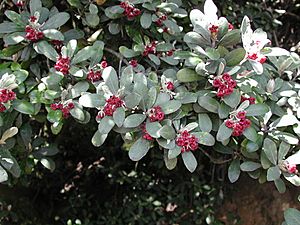Karo facts for kids
Quick facts for kids Karo |
|
|---|---|
 |
|
| Scientific classification | |
| Genus: |
Pittosporum
|
| Species: |
crassifolium
|
The Karo (scientific name: Pittosporum crassifolium) is a small tree or shrub. It is also known as stiffleaf cheesewood. In the Māori language, it is called karo, kaikaro, and kīhihi. This plant is originally from New Zealand.
About the Karo Plant
The Karo plant first grew in the northern part of New Zealand's North Island. Today, you can find it growing naturally all over New Zealand. It has also spread to places like Norfolk Island and Hawaii. Karo plants usually grow in forests near the coast or in low-lying areas. A full-grown Karo tree can reach about 5 metres (16 ft) (about 16 feet) tall.
What Karo Looks Like
Karo plants have thick, dark gray-green leaves. These leaves feel a bit like leather. The underside of the leaves is covered in soft fur. In the spring, small red-purple flowers grow in groups. These flowers later turn into seed pods. When the pods open, they show sticky seeds inside.
How Karo Spreads
Karo is known as an early coloniser. This means it is one of the first plants to grow in new or disturbed areas. It is very strong and can handle strong winds and salty ocean spray.
Birds love to eat the sticky seeds of the Karo plant. They then fly to new places and drop the seeds. This helps the Karo spread easily. In some parts of New Zealand, especially south of where it naturally grows, Karo has become a "pest plant." This means it spreads too much and can take over areas, sometimes pushing out other native plants.
In California, people are watching Karo plants carefully. They are worried that the plant might spread into the wild there. If it does, it could become a problem, like it has in some parts of New Zealand.
Images for kids



